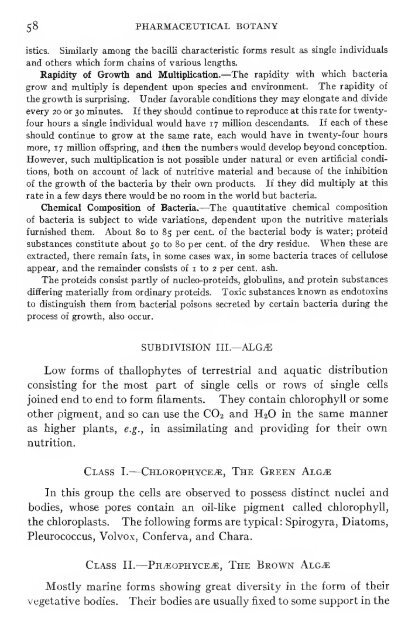Pharmaceutical botany - Lighthouse Survival Blog
Pharmaceutical botany - Lighthouse Survival Blog
Pharmaceutical botany - Lighthouse Survival Blog
Create successful ePaper yourself
Turn your PDF publications into a flip-book with our unique Google optimized e-Paper software.
58<br />
PHARMACEUTICAL BOTANY<br />
istics. Similarly among the bacilli characteristic forms result as single individuals<br />
and others which form chains of various lengths.<br />
Rapidity of Growth and Multiplication.—The rapidity with which bacteria<br />
grow and multiply is dependent upon species and environment. The rapidity of<br />
the growth is surprising. Under favorable conditions they may elongate and divide<br />
every 20 or 30 minutes. If they should continue to reproduce at this rate for twenty-<br />
four hours a single individual would have 17 million descendants. If each of these<br />
should continue to grow at the same rate, each would have in twenty-four hours<br />
more, 17 million offspring, and then the numbers would develop beyond conception.<br />
However, such multiplication is not possible under natural or even artificial condi-<br />
tions, both on account of lack of nutritive material and because of the inhibition<br />
of the growth of the bacteria by their own products. If they did multiply at this<br />
rate in a few days there would be no room in the world but bacteria.<br />
Chemical Composition of Bacteria.—The quantitative chemical composition<br />
of bacteria is subject to wide variations, dependent upon the nutritive materials<br />
furnished them. About 80 to 85 per cent, of the bacterial body is water; proteid<br />
substances constitute about 50 to 80 per cent, of the dry residue. When these are<br />
extracted, there remain fats, in some cases wax, in some bacteria traces of cellulose<br />
appear, and the remainder consists of i to 2 per cent. ash.<br />
The proteids consist partly of nucleo-proteids, globulins, and protein substances<br />
differing materially from ordinary proteids. Toxic substances known as endotoxins<br />
to distinguish them from bacterial poisons secreted by certain bacteria during the<br />
process of growth, also occur.<br />
SUBDIVISION III.—ALGiE<br />
Low forms of thallophytes of terrestrial and aquatic distribution<br />
consisting for the most part of single cells or rows of single cells<br />
joined end to end to form filaments. They contain chlorophyll or some<br />
other pigment, and so can use the CO2 and H2O in the same manner<br />
as higher plants, e.g., in assimilating and providing for their own<br />
nutrition.<br />
Class I. Chlorophyce^, The Green Alg^<br />
In this group the cells are observed to possess distinct nuclei and<br />
bodies, whose pores contain an oil-like pigment called chlorophyll,<br />
the chloroplasts. The following forms are typical : Spirogyra, Diatoms,<br />
Pleurococcus, Volvo.x, Conferva, and Chara.<br />
Class II. Ph^ophyce^, The Brown Alg^<br />
Mostly marine forms showing great diversity in the form of their<br />
vegetative bodies. Their bodies are usually fixed to some support in the
















